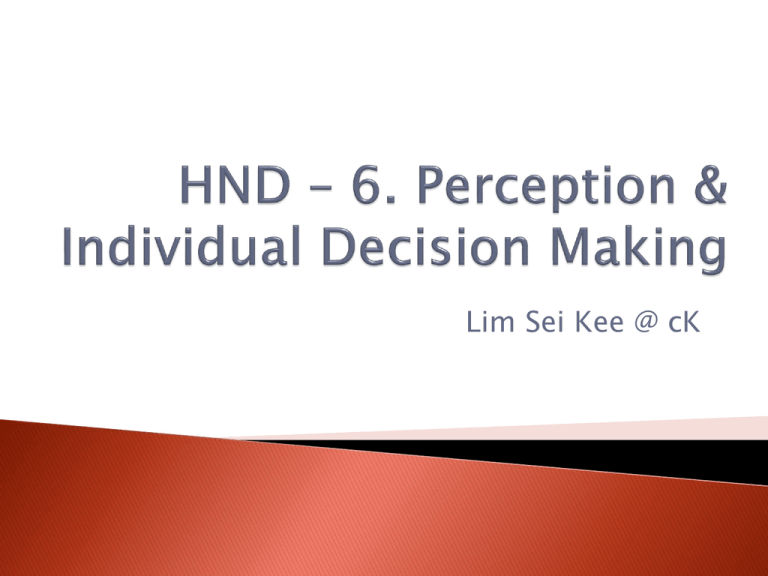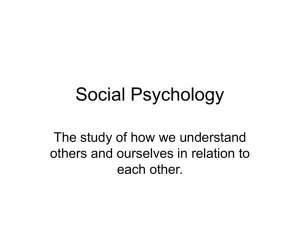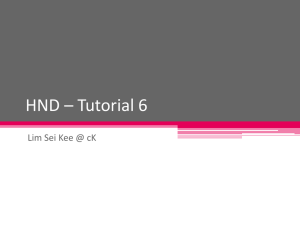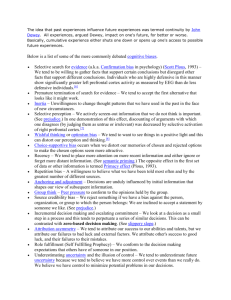HND – 6. Perception & Individual decision making
advertisement

Lim Sei Kee @ cK A process by which individuals organize and interpret their sensory impressions in order to give meaning to their environment. •People’s behavior is based on their perception of what reality is, not on reality itself. Perception is the process by which individuals make sense of their world. Individuals may look at the same thing, yet perceive it differently. Differences in perceptions can cause problems ◦ ◦ ◦ ◦ ◦ Communication Conflict Motivation Judgment Decision Making FACTORS IN THE PERCEIVER Attitudes Motives Interests Experience Expectations FACTORS IN THE TARGET •Motion •Sounds •Size •Background •Similarity PERCEPTION FACTORS IN THE SITUATION Time Work setting Social setting Attribution Theory When individuals observe behavior, they attempt to determine whether it is internally or externally caused. Distinctiveness: shows different behaviors in different situations. Consensus: response is the same as others to same situation. Consistency: responds in the same way over time. Suggests that perceivers try to “attribute” the observed behavior to a type of cause: ◦ Internal – behavior is believed to be under the personal control of the individual ◦ External –the person is forced into the behavior by outside events/causes 1. Fundamental attribution error The tendency to underestimate the influence of external factors and overestimate the influence of internal factors when making judgments about the behavior of others. The tendency to attribute others' bad performance to internal causes & Attribute their good performance to external causes 2. Self-serving bias The tendency for individuals to attribute their own successes to internal factors while putting the blame for failures on external factors. attribute successes to ourselves – internal attribute failures to the environment – external Selective perception Halo effect Contrast effect Projection Stereotyping Self-fulfilling prophecy Profiling Selective Perception People selectively interpret what they see on the basis of their interests, background, experience, and attitudes. Halo Effect Drawing a general impression about an individual on the basis of a single characteristic Contrast Effects Evaluation of a person’s characteristics that are affected by comparisons with other people recently encountered who rank higher or lower on the same characteristics Projection Stereotyping Attributing one’s own characteristics to other people Judging someone on the basis of one’s perception of the group to which that person belongs Self-fulfilling prophecy – a situation in which one person inaccurately perceives a second person and the resulting expectations cause the second person to behave in ways consistent with the original perceptions. Profiling – a group of individuals is singled out – typically on the basis of race or ethnicity – for intensive inquiry or investigation. Problem A perceived discrepancy between the current state of affairs and a desired state. Decisions Choices made from among alternatives developed from data perceived as relevant. Perception of the decision maker Outcomes Making consistent, value-maximizing choices within specified constraints. Rational decision-making decision-making model model that – a describes how individuals should behave in order to maximize some outcome. Rational DecisionMaking Model Model Assumptions Describes how individuals should behave in order to maximize some outcome. • Known options • Problem clarity • Clear preferences • Constant preferences • No time or cost constraints • Maximum payoff 1. Define the problem. 2. Identify the decision criteria. 3. Allocate weights to the criteria. 4. Develop the alternatives. 5. Evaluate the alternatives. 6. Select the best alternative. The ability to produce novel and useful ideas Helps people to: ◦ ◦ ◦ ◦ Better understand the problem See problems others can’t see Identify all viable alternatives Identify alternatives that aren’t readily apparent Expertise CreativeThinking Skills Intrinsic Task Motivation Proposes that individual creativity requires expertise, creative-thinking skills and intrinsic task motivation Expertise – foundation for all creative work Creative-thinking skills – personality characteristics associated with creativity. Intrinsic task motivation - desire to work on something Bounded Rationality Individuals make decisions by constructing simplified models that extract the essential features from problems without capturing all their complexity. Simpler than rational decision making, composed of three steps: 1. Limited search for criteria and alternatives – familiar criteria and easily found alternatives 2. Limited review of alternatives – focus alternatives, similar to those already in effect 3. Satisficing – selecting the first alternative that is “good enough” Overconfidence bias Anchoring bias Confirmation bias Availability bias Representative bias Escalation of Commitment bias Randomness Error Hindsight bias Overconfidence Bias ◦ Believing too much in our own ability to make good decisions ◦ ‘no problem in judgment and decision making’ Anchoring Bias ◦ Using early, first received information as the basis for making subsequent judgments ◦ a tendency to fixate on initial information as a starting point. Confirmation Bias ◦ Using only the facts that support our decision ◦ a specific case of selective perception; we seek out information that reaffirms our past choices, and we discount information that contradicts past judgments Availability Bias ◦ Using information that is most readily at hand ◦ the tendency for people to base their judgments on information that is readily available to them Representative Bias ◦ Assessing the likelihood of an occurrence by trying to match it with a preexisting category using only the facts that support our decision Escalation of Commitment ◦ In spite of new negative information, commitment actually increases ◦ Increasing commitment to a previous decision in spite of negative information. Randomness Error ◦ Creating meaning out of random events ◦ difficulty dealing with chance. Hindsight Bias ◦ Looking back, once the outcome has occurred, and believing that you accurately predicted the outcome of an event ◦ Hindsight = ability to see, after the event, what should have been done An non-conscious process created out of distilled experience Increases with experience Can be a powerful complement to rational analysis in decision making Eight conditions for intuitive decision making – When high level of uncertainty exists When there is little precedent to draw on When variables are less scientifically predictable When ‘facts’ are limited When facts don’t clearly point the way When analytical data are of little use When there are several plausible alternative solutions from which to choose When time is limited and there is pressure Directive – low tolerance for ambiguity and seek rationality Analytic – greater tolerance for ambiguity Conceptual – tend to use data from multiple sources and consider many alternatives Behavioral – strong concern for the people in the organization and their development Source: A.J. Rowe and J.D. Boulgarides, Managerial Decision Making, (Upper Saddle River, NJ: Prentice Hall, 1992), p. 29. Ethical Decision Criteria ◦ Utilitarianism Seeking the greatest good for the greatest number. ◦ Rights Respecting and protecting basic rights of individuals such as whistleblowers. ◦ Justice Imposing and enforcing rules fairly and impartially. 1. 2. 3. 4. 5. Analyze the situation and adjust your decision making style to fit the situation. Be aware of biases and try to limit their impact. Combine rational analysis with intuition to increase decision-making effectiveness. Don’t assume that your specific decision style is appropriate to every situation. Enhance personal creativity by looking for novel solutions or seeing problems in new ways, and using analogies.






